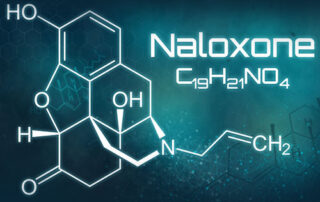1.2 million opioid overdose deaths is 1.2 million too many
The opioid epidemic has become one of the most devastating public health emergencies of our time. According to a February 2023 report from the Stanford-Lancet Commission on the North American Opioid Crisis, 1.2 million people in the US and Canada are expected to die of opioid overdose by the end of the decade. Powerful illicit drugs have infiltrated our cities, towns, neighborhoods and schools, and could claim the lives of the people we love. That’s why it’s important to understand the opioid epidemic and the interventions that can help keep ourselves, our families and our communities safe.
Be prepared. Take action. Save lives.
Ask your doctor about KLOXXADO® (naloxone HCl) Nasal Spray 8 mg and how you can be ready to save a life from an opioid overdose.
About the opioid epidemic
According to the Centers for Disease Control, the opioid epidemic is a decades-old problem. However, the most recent wave of deaths–largely driven by illicitly manufactured fentanyl and other synthetic opioids–has been by far the most significant.
The stress, isolation and other hardships experienced by so many during the COVID-19 pandemic may have exacerbated what was already an unprecedented public health crisis. According to the National Center for Health Statistics, annual overdose deaths surged by 50% during the COVID-19 pandemic.
According to the Centers for Disease Control, more than 100,000 people died of a drug overdose in 2021 alone. This spike in overdose deaths can be partly attributed to the flood of illicitly manufactured fentanyl coming into the illegal drug supply. In 2022, the US Drug Enforcement Administration (DEA) seized enough fentanyl to kill every person in the US. The tiniest dose of the drug—just 2 milligrams—can be lethal, and it can be found in every corner of our society.
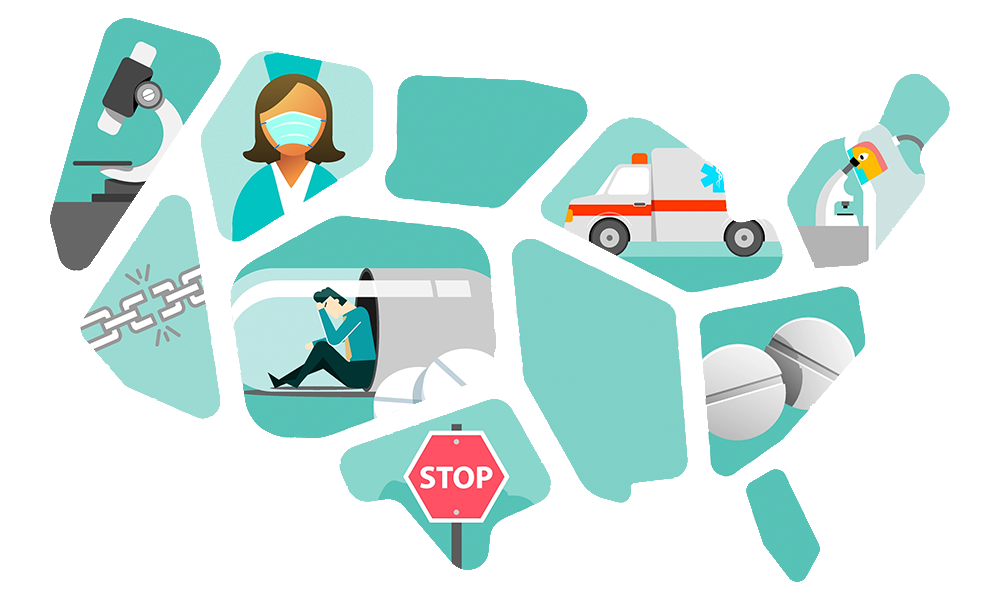
“[Illicit] fentanyl is the single deadliest drug threat our nation has ever encountered. Fentanyl is everywhere. From large metropolitan areas to rural America, no community is safe from this poison. We must take every opportunity to spread the word to prevent fentanyl-related overdose death and poisonings from claiming scores of American lives every day.”
Anne Milgram
Former DEA Administrator
Types of illicit opioids
Reducing opioid overdose deaths with naloxone
As the opioid epidemic has progressed, the illicit drugs have become more potent and pervasive.
Most people who use illegal drugs do not think they will die of an overdose, but accidents happen. Accidental overdoses do not have to be fatal, however. Nearly 40 percent of overdose deaths involving opioids happen with someone nearby.14 If a bystander is armed with naloxone, the outcome could be different.
If you or someone you know is at risk for opioid overdose, you should keep naloxone with you at all times. Life-saving naloxone medications like KLOXXADO® are small to carry and easy to use. Naloxone can quickly reverse an overdose by blocking the effects of the opioid and restoring breathing—usually within 2 to 3 minutes. KLOXXADO® is safe to use even if opioids aren’t present, so it’s always best to use naloxone if you suspect that a person is experiencing an overdose. If you give someone naloxone for suspected opioid overdose, be sure to stay with them until emergency help arrives.
Understanding opioid overdose
Since 1999, more than one million people have died from drug overdoses, with opioid overdose being the leading cause of accidental death in the United States.
Although death is the worst consequence of opioid overdose, it is important to keep in mind that even a non-fatal overdose is damaging if not reversed quickly enough. Brain injury can occur as a result of slowed heart rate and breathing.
- Limb weakness
- Balance and coordination issues
- Spasticity or rigidity in muscle tone
- Abnormal, involuntary movements
- Loss of vision
- Memory loss
- Speech and language challenges
- Changes in cognitive abilities related to thinking and decision making that can impact future planning, work and social interactions
- Changes in personality, including irritability, impulsiveness and social impairments
Brain injury can present new challenges that can be difficult to manage, especially if the overdose survivor is also trying to cope with substance use.27 It can take a long time to determine the extent of the damage and establish a continuing care plan to help the person recover.27 In addition to the physical effects, brain injury can have a significant impact on a person’s mental health and well-being.27
KLOXXADO® and opioid overdose reversal
As illicit opioids become stronger and more widely available, the need for naloxone access is critical. Accidental opioid overdose can happen anywhere, carrying nasal naloxone such as KLOXXADO® may help prevent an accidental opioid overdose from being fatal. KLOXXADO® provides an option for 8 mg of naloxone per spray in a single dose.
How does KLOXXADO® work?
Naloxone, the active ingredient in KLOXXADO® Nasal Spray, is a medicine called an opioid antagonist. It works by attaching to the opioid receptors in the brain and reversing or blocking the action of the opioid. By reversing or blocking the action of the opioid, KLOXXADO® can quickly restore normal breathing in someone who is suffering with an opioid overdose. It is sprayed directly in the person’s nostril and does not require evidence of breathing through the nose during administration.
Key Steps For Administering KLOXXADO® Nasal Spray
KLOXXADO® Nasal Spray is not a substitute for emergency medical care.
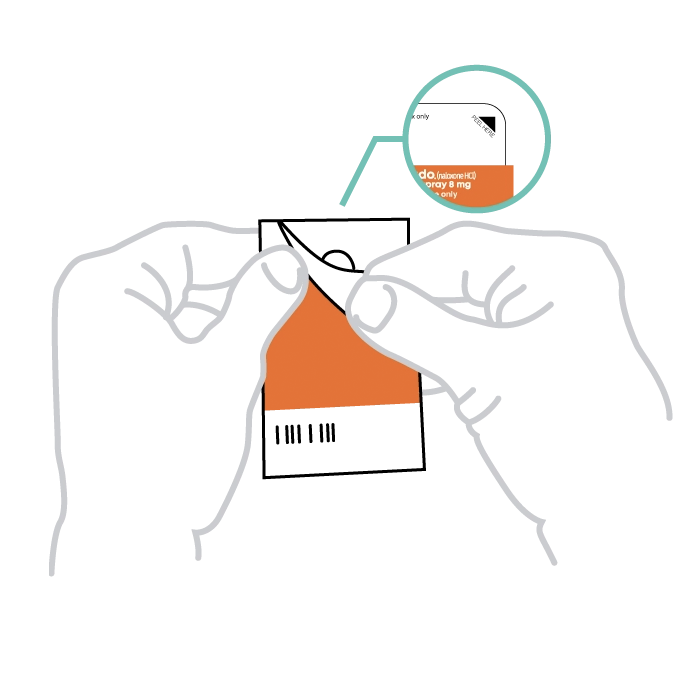
1. REMOVE
Remove KLOXXADO® Nasal Spray from the box. Peel off the back tab with the triangle to open the KLOXXADO® Nasal Spray blister.
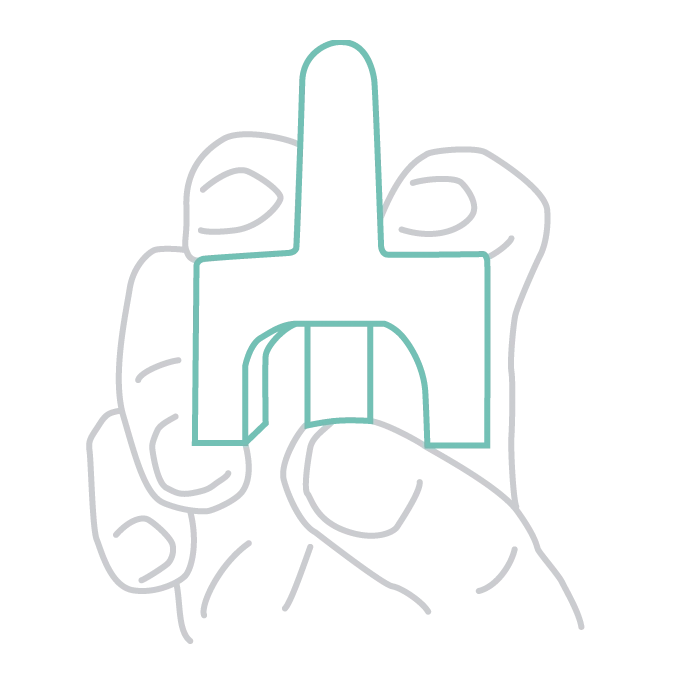
2. HOLD
Hold it with your thumb on the bottom and your first and middle fingers on either side of the nozzle.
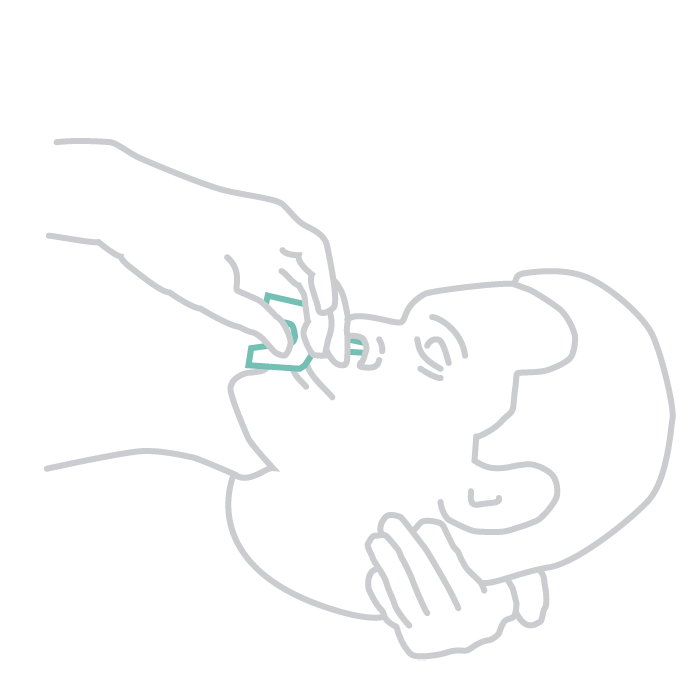
3. INSERT
Insert the tip of the nozzle into one nostril until your fingers are against the bottom of the person’s nose.

4. PRESS
Press the plunger firmly to give the dose of KLOXXADO® Nasal Spray.
5. CALL 911
After giving KLOXXADO® Nasal Spray to someone, call 911 and stay with them until emergency help arrives.

6. ADDITIONAL DOSES
If a person is given KLOXXADO® and does not respond after 2-3 minutes, administer another dose.
If a person responds then overdose symptoms continue, additional doses of KLOXXADO® may be given every 2-3 minutes until emergency medical assistance arrives.
Use as directed.
Ideally, emergency medical services (EMS) will arrive before a second dose of KLOXXADO® is needed. If the person has not responded after a few minutes and EMS still has not arrived, a second dose of KLOXXADO® may be necessary. This might happen in the case of an overdose that involves strong opioids or if the naloxone wears off before the opioids do.
You can administer additional doses of KLOXXADO® every 2 or 3 minutes (in alternating nostrils) if the overdose person does not respond, responds insufficiently or loses consciousness.
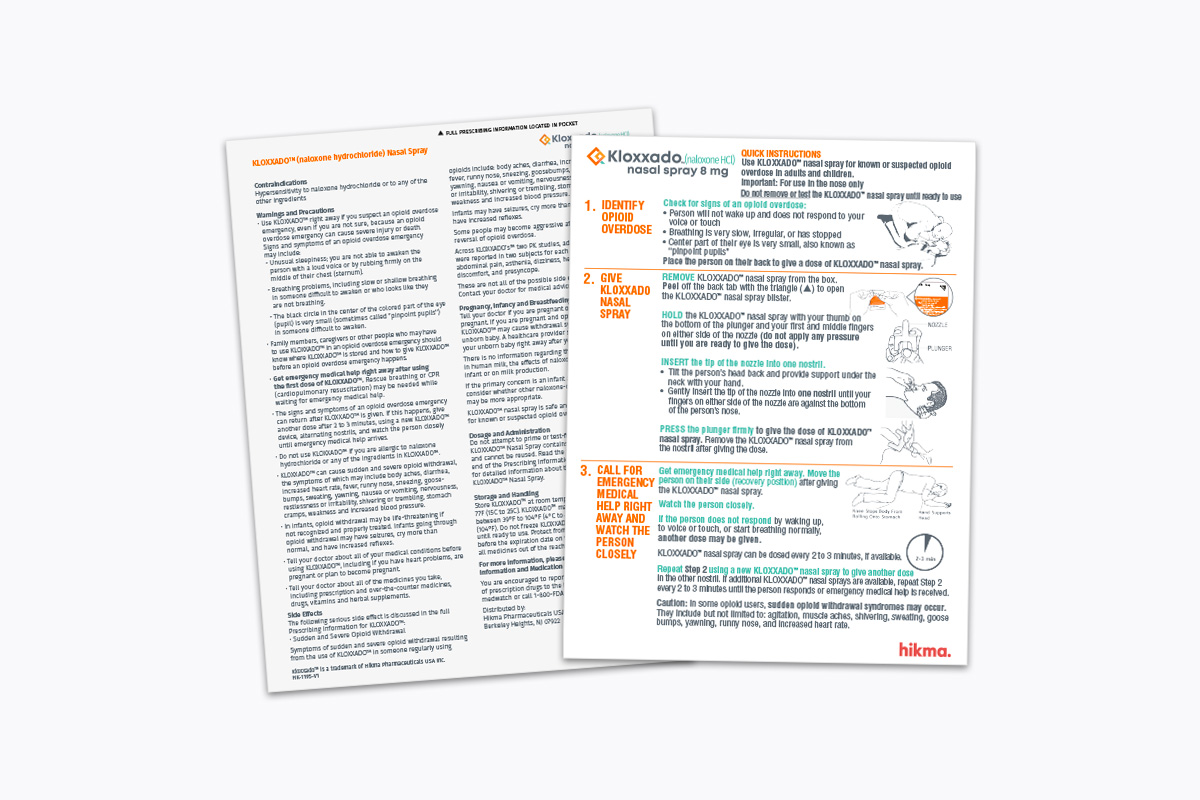
KLOXXADO® Quick Use Instructions
Easy-to-follow instructions for administering KLOXXADO®.
Opioid and overdose FAQs
Naloxone, the medicine in KLOXXADO®, works only if a person has opioids in their system.*† It is safe to use even if opioids aren’t present.† Administering naloxone is unlikely to harm someone, but it could save their life if they are experiencing an opioid overdose.†
* KLOXXADO® (naloxone HCl) Nasal Spray [prescribing information]. Columbus, OH: Hikma Specialty USA Inc., 2021
† Access to Naloxone Can Save a Life During an Opioid Overdose. US Food and Drug Administration website. Available at: https://www.fda.gov/consumers/consumer-updates/access-naloxone-can-save-life-during-opioid-overdose. Accessed March 5, 2023.
If you or someone you love is at risk for misusing opioids, resources and help are available. Find information about substance use disorder treatment options on findtreatment.gov, a product of the Substance Abuse and Mental Health Services Administration. Connect with harm reduction resources near you at harmreduction.org, the official website of the National Harm Reduction Coalition.
In two pharmacokinetic (PK) studies of 47 healthy adult volunteers, the following adverse reactions were reported in two subjects each: abdominal pain, asthenia, dizziness, headache, nasal discomfort, and presyncope.
The most common side effects in adults include: stomach-area (abdomen) pain, weakness, dizziness, headache, nose (nasal) discomfort, and a feeling like you are going to faint.*
Serious side effects include sudden opioid withdrawal symptoms. In someone who has been using opioids regularly, opioid withdrawal symptoms can happen suddenly after receiving KLOXXADO® Nasal Spray and may include body aches, diarrhea, increased heart rate, fever, runny nose, sneezing, goose bumps, sweating, yawning, nausea or vomiting, nervousness, restlessness or irritability, shivering or trembling, stomach cramping, weakness, or increased blood pressure.*
For more information, please see the full Prescribing Information and Important Safety Information.
To report an adverse event or product complaint, please contact us at [email protected] or call 1-877- 845-0689 or 1-800-962-8364. Adverse events may also be reported to the FDA directly at 1-800-FDA-1088 or www.fda.gov/medwatch.
* KLOXXADO® (naloxone HCl) Nasal Spray [prescribing information]. Columbus, OH: Hikma Specialty USA Inc., 2021
Opioids work by attaching to specific receptors found in the brain and in the nervous system.‡ This includes the nerves that sense pain, as well as the nerves that control breathing.† Taking too many opioids can lead to an overdose and that can stop someone from breathing.‡
Naloxone, the active ingredient in KLOXXADO®, stops the opioids from attaching to the receptors on the nerves.* This reverses the effects and symptoms of the overdose.*†
KLOXXADO® Nasal Spray is administered in the nostril and does not require evidence of breathing through the nose during administration.*
Get emergency medical help right away in any case of known or suspected overdose emergency. KLOXXADO® Nasal Spray is not a substitute for emergency medical care.* Administer in accordance with the instructions provided in the KLOXXADO® Quick Instructions resource.
Each device is a single dose.* If an additional dose is needed, you must use another device.*
* KLOXXADO® (naloxone HCl) Nasal Spray [prescribing information]. Columbus, OH: Hikma Specialty USA Inc., 2021.
† NIDA 2021. “Naloxone DrugFacts,” National Institute on Drug Abuse, https://www.drugabuse.gov/publications/drugfacts/naloxone, Accessed May 3, 2021.
‡ White JM & Irvine RJ. 1999, “New Horizons/Mechanisms of fatal opioid overdose,” Addiction, 94(7):961–972.
KLOXXADO® provides an option for 8 mg of naloxone HCl per spray in a single dose.* KLOXXADO® can be used by anyone to reverse the effects of an opioid overdose until medical help arrives.* Each box of KLOXXADO® contains two individually packaged single-spray devices.*
Always carry KLOXXADO® with you in case of an opioid emergency.
* KLOXXADO® (naloxone HCl) Nasal Spray [prescribing information]. Columbus, OH: Hikma Specialty USA Inc., 2021

Patient and Caregiver Resources
Find product information, as well as opioid addiction and overdose resources.







